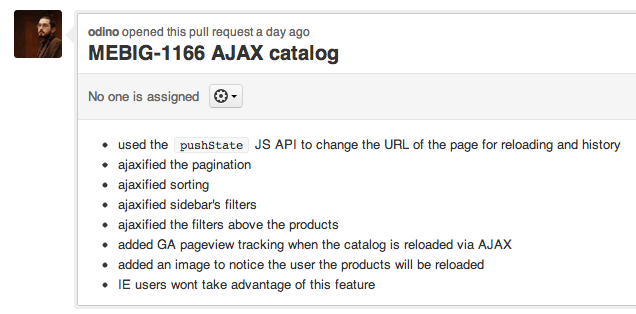When I joined Rocket Internet 4 months ago, here in Dubai, the team was about to experience the transition from the very old SVN to Git, with everything hosted on Github.
In this post I try to wrap-up the impressions of the team and the changes in the lifecycle of our source code with the adoption of the Git+Github combo.

Premise
We had our first meeting about the switch to Git after our CTO migrated our repositories from our hosted SVN repos to Github with git-svn.
In that meeting – useful for a lot of people who never used Git before – we explained the basic stuff that you should know to get started with this VCS:
- distribute vs centralized versioning system
- Github act as a remote
commitis localpush,pullandfetch- rebasing
- branching and merging
- gitflow
All in all we wanted to follow gitflow but at the end it turned out that in some parts we had to simplify the workflow and add more complexity somewhere else: keep reading to get more insights.
Our development workflow
So let’s say that today we have master and dev aligned:
masteris an always-ready-to-be-released branch, in which you commit code that is tested and works on production: the aim is to have a solid fallback if you deploy and need to rollback ( capistrano would probably be a better solution, since it’s more immediate, but again you need an history of working versions )devbranches frommaster: it’s the integration branch, where you merge features developed for your next release
As the days go by, people will branch from develop to implement new features/fix bugs:
1 2 | |
The developer is free to handle its ticket with both local and remote branches: although pushing to the remote makes squashing harder, I would always recommend to push every day.
Let’s say that the bugfixing seems done and we are ready
to include that code in the develop, which is gonna lead
to our next release: the developer now opens a pull request
from its branch to develop:

It’s always useful to name the PR like TICKET-ID Headline
and add a few more comments to explain your changes, if it’s worth it:
given that you name your branches after the tickets that they
implement/fix, adding the ticket ID to the PR’s title lets
who needs to merge it into develop to directly copy the branch
name from Github – otherwise you need to type it manully2.
The release manager ( who reviews PRs and merges them into the integration branch ) can now have a look at your PR, comment it and accept or reject it:
- if it’s accepted it gets merged and the ticket status
changes from
bugfixing1 toReady for QA - if rejected it’s re-assigned back to the developer, and technical comments are added directly on Github
1 2 3 4 | |

Now times has come to go live with a set of changes:
a release branch is created and we tag version
X.Y.Z-beta1, that is gonna be deployed in the first
development environment ( sort of pre-staging ).
If some tests are not passing, the developers add the
related fixes and open the PRs in the release branch
( release-X.Y.Z ), so we re-tag and redeploy ( X.Y.Z-beta2 ):
if someone is working on other tickets, which don’t have to
be included in version X.Y.Z, the integration branch
is still develop.
After this, a new tag X.Y.Z-rc1 is deployed into the
staging environment: if everything is good we create a
new tag, X.Y.Z and go live with it.
After a few hours, we can consider this tag valid
and update both master and develop:
1 2 3 4 5 6 | |
The development cycle starts again.
Critical paths
There are some problematic aspects to consider when you are working with almost 10 people daily pushing/pulling from the same remote:
- when you rebase
develop, pull request can include old commits that are already merged, so you just need to ask for a rebase of the PR’s branch - when you rebase
develop, always ask people to pull the remote develop in their local ones, otherwise they will be working with a different tree ( after the rebase Git is not smart enough to connect the pre-rebase and after-rebase trees ) - if you need to do an hotfix deployment, always branch from
masteror the release branch ( if the related tag wasn’t merged intomaster): you don’t want tocherry-pickcommits and then manually update the PR which takes care of the hotfix
Conclusions
All in all I think our process has improved so much: first of all we see less conflicts, thanks to the Git engine3, second we have more control, transparency and visibility towards code: being able to comment every single line of code on Github really helps you when you need to handle several PRs at once; not to mention the fact that doing release-management is way easier.
By the way, pull request are another good stage of the workflow, since they let the developer take a final look at the code, review it for the last time and explain it in the PR message, something that with SVN and SVN-based services ( like GH ) was nearly impossible.
Additionally, coming from Atlassian’s hosted services, Github gives you the reliability I always missed: no apparent downtime so far and pulling/pushing is really fast; compared to SVN, this is a huge win for us.
At the end I’d say that we almost doubled our potential with these changes, and I think it’s 50% because of Git and another 50% ‘cause of Github: if you don’t use them, I definitely recommend you to switch as soon as possible4.
- We use ‘bigfixing’ both for new features and bugs, it’s just to identify a status in which the developer is working on the ticket ↩
- Github’s markup makes it difficult to `ctrl+c` it from the “You’re asking @user to merge 1 commit into repo:develop from repo:TICKET-ID” string ↩
- But this can just be just my personal feeling ↩
- BitBucket is a pretty cheap alternative to Github ↩